A Step-by-Step Guide on How to Do Competitor Analysis Content Marketing

Only 29 % of marketers report having a documented content strategy that's truly effective, and yet 88 % expect budgets to rise in 2025. What’s the takeaway?
Competitor content marketing analysis isn't optional but essential. Ignoring your competitors can mean missing out on traffic, rankings, and conversions. Every blog post, video, or social update they publish gives you a direct window into what works in your industry and what doesn’t. The question is only whether you pay attention.
How to do competitor analysis content marketing? In this step-by-step guide, we’ll break down how to identify your true content competitors, dissect their SEO (search engine optimization) and engagement metrics, and evaluate content quality to see where you can outperform them. You’ll also learn how to avoid the most common pitfalls marketers make during content competitor analysis and which tools can simplify the process.
If you’re serious about creating content that ranks, converts, and leaves competitors behind, keep reading!
What is competitor content analysis in marketing?
It's necessary to set the record straight before we dive into the definition of content analysis marketing. The incorrect frame of mind causes many companies to implement ineffective strategies and squander resources when it comes to how to do content marketing competitor analysis. First things first, let's clarify what competitor content analysis is NOT:
It’s not spying on your competitors or stealing their ideas.
It’s not blindly copying formats, keywords, or visuals.
It’s not a one-time task you do at the start of a campaign.
It’s not focused only on SEO rankings without considering user experience.
It’s not about chasing every trend your competitors adopt.
Content competitive analysis isn’t about copying, as many mistakenly assume. Rather, it’s about decoding patterns, spotting weaknesses, and finding opportunities you may have overlooked. It allows you to understand the reasons behind their success or failure, and use that insight to create content that resonates better with your audience.
When done correctly, content analysis marketing turns into a huge strategic advantage. You have clarity on where to innovate, how to differentiate, and how to build content that stands out in a crowded market. In Loona Agency’s experience, brands that integrate competitor insights into their content workflow see stronger engagement, higher rankings, and a faster path to authority in their niche.
Most importantly, this approach ensures that instead of reacting to every move competitors make, you shape your own path forward. You’re informed by their strengths but focused on building a unique voice and value for your audience. That’s where lasting growth begins.
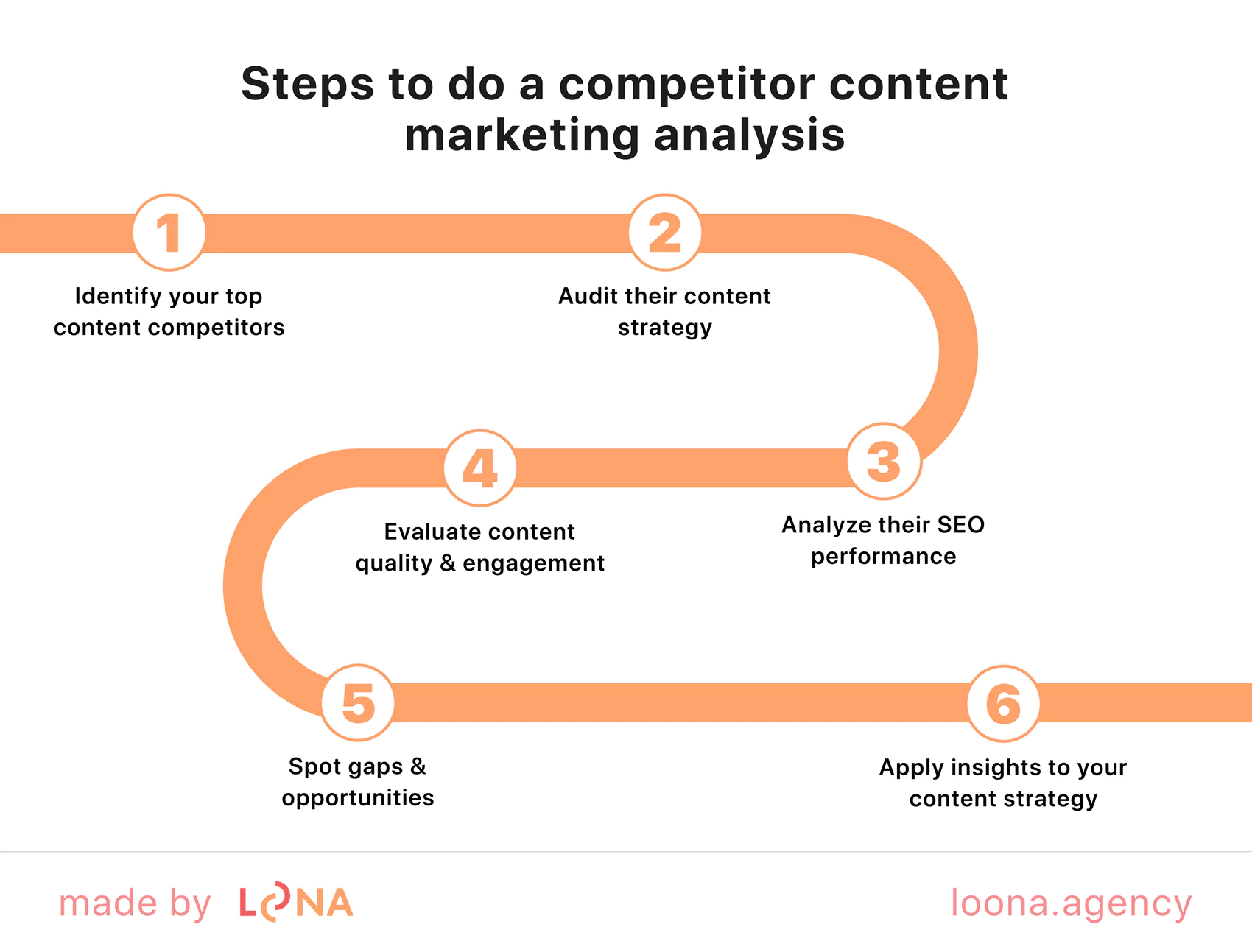
Step 1: Identify your top content competitors
Before you can outperform your competitors, you need to know exactly who they are. Many brands make the mistake of only considering direct business competitors (those selling the same product or service) and overlook content competitors: websites or influencers dominating the search results and conversations in your niche.
For example, a local furniture brand might compete with national retailers for rankings on “best sofa materials” or even interior design blogs that don’t sell furniture at all.
To identify these competitors, start with keyword research. Look up the terms your audience is searching for and see who consistently ranks on the first Google page. Analyze which blogs, YouTube channels, or social accounts create content your target audience engages with most.
Loona Agency’s competitive content analysis marketing approach combines search data, market mapping, and social listening to create a full picture of your competitive landscape, uncovering rivals you might never have considered.
The goal isn’t just to make a list but to prioritize which competitors matter most to your strategy. Focus on those generating high traffic, strong engagement, or ranking for the keywords most relevant to your business goals.
Step 2: Audit their content strategy
Once you know who your competitors are, the next step is how to see competitors marketing strategy. This isn’t about scrolling through a few blog posts but understanding their approach, consistency, and positioning. Look at how often they publish, the topics they prioritize, and the formats they use (blogs, videos, infographics). Are they focusing on thought leadership, quick tips, or deep guides?
Loona Agency recommends looking beyond the surface: What emotions are they tapping into? Which pain points are they solving? This helps you see why their content resonates, or why it doesn’t. You can also check whether they repurpose content across channels, like turning blogs into LinkedIn posts or videos, to stretch their reach.
When you audit content strategy, you uncover patterns and gaps. If competitors post frequently but lack depth, you can win with higher quality insights. If they focus on one topic but ignore another your audience cares about, that’s your opening. This competitor analysis content stage builds the foundation for a smarter, more focused marketing plan.
Step 3: Analyze their SEO performance
A strong content strategy without SEO looks good, but no one sees it. Analyzing competitor SEO reveals why they rank, how they attract traffic, and where you can beat them. Key areas to examine in competitor SEO performance are the following:
Keyword rankings. Which terms bring them the most traffic? Are they targeting high‑intent or broad keywords?
Backlink profile. Who links to them, and are those links high-quality and relevant?
Page speed & technical health. Do their pages load fast, use HTTPS, and pass Core Web Vitals?
Content structure. Are their titles, meta descriptions, and headings optimized for search and readability?
Internal linking. Do they guide users (and crawlers) effectively to key pages?
Mobile optimization. How well do they perform on mobile, where most users browse?
Engagement signals. Bounce rate, dwell time, and CTRs that indicate content relevance.
When you know how competitors achieve visibility, you can adjust your own strategy, either targeting overlooked keywords, building stronger backlinks, or improving site structure. Loona Agency uses this data-driven approach to website design SEO strategies that compete and outperform over time.
Step 4: Evaluate content quality & engagement
After understanding competitors’ strategy and SEO, it’s time to assess how well their content performs with the audience. High rankings don’t always equal high impact. It’s quality and engagement that reveal whether people trust, share, and act on what they see.
Start by reviewing readability and depth. Are their articles with clear headings, visuals, and bullet points, or are they dense walls of text? Do they provide original insights or just repeat common knowledge? Loona Agency’s content SEO competitor analysis considers both substance and style because content that looks polished but lacks value won’t hold attention for long.
Next, check engagement signals: comments, shares, likes, and dwell time. Are users interacting or bouncing quickly? Tools like BuzzSumo or even direct social analytics can show which topics spark the most reactions. Also, consider tone. Is it authoritative, friendly, or inconsistent across platforms?
Evaluating quality and engagement helps you pinpoint what resonates and what doesn’t. If competitors have strong SEO but low engagement, you can stand out by creating content that’s equally optimized yet more compelling.
Step 5: Spot gaps & opportunities
Once you’ve mapped competitors’ strategies, SEO, and content quality, the next step is finding what they’re missing, and how you can fill those gaps better than anyone else. These content SEO competitor analysis openings often appear in overlooked topics, weak keyword coverage, outdated content, or poor UX (user experience).
Start by asking: What questions aren’t they answering? Which audience segments are they ignoring? Sometimes the opportunity lies in content format. If they rely only on blogs, you might stand out with video or interactive tools. Loona Agency uses advanced audits to cross‑match competitor content with audience search behavior, revealing areas where valuable topics have little competition.
Spotting gaps implies doing smarter content. When you identify the spaces your competitors left open, you can position your brand as the go‑to authority. This step turns competitor analysis from observation into action, and sets the stage for building a powerful content strategy
Step 6: Apply insights to your content strategy
Analyzing competitors only matters if you turn findings into action. Consider refining your content topics, formats, and distribution to outperform others in the market. At Loona Agency, this is where strategy shifts from data to execution. Here’s our experience-based advice on how to apply competitor content marketing analysis insights effectively:
Prioritize gaps. Focus on high-impact opportunities: keywords, topics, or formats competitors missed.
Refine your voice. If rivals sound generic, build a stronger tone that connects emotionally with your audience.
Upgrade formats. Turn static blogs into interactive tools, videos, or infographics to boost engagement.
Strengthen SEO. Improve on-page structure, load speed, and backlinks where competitors are weak.
Plan distribution. Share on the right channels: where your audience is active, not just where competitors post.
When you integrate these insights, your content strategy stops being reactive and starts being proactive. You set the standard that competitors will try to match. This is the point where brands, with Loona Agency’s guidance, see rankings rise, engagement grow, and leads convert faster.
Tools to help you with competitor content analysis
The right tools turn competitor analysis from assumptions into precise, data‑driven insights. They help uncover ranking keywords, backlink strategies, traffic sources, and content performance so you can make smarter decisions faster. Recommended tools for competitor analysis:
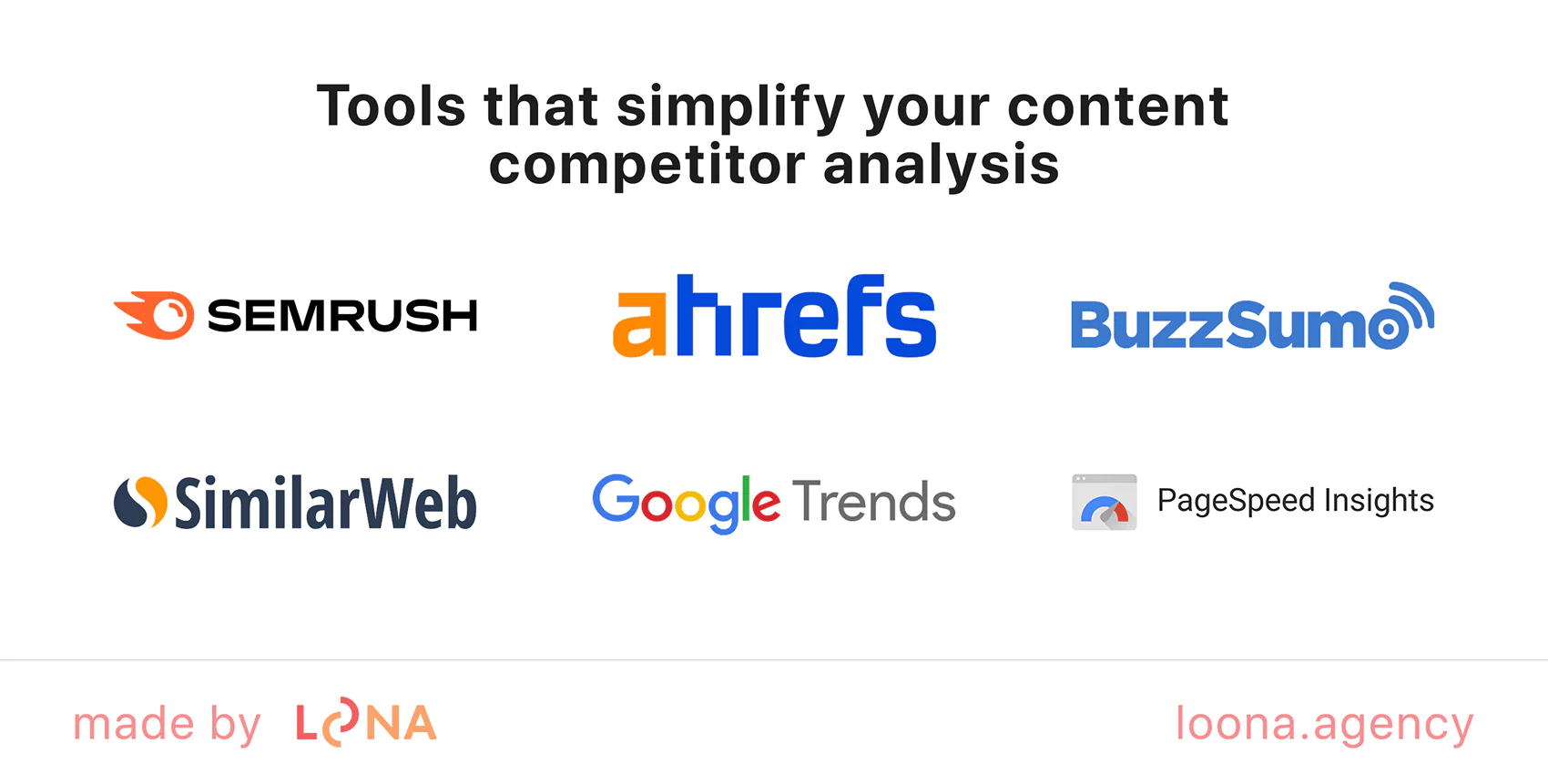
SEMrush
A full‑suite marketing platform that tracks competitor keyword rankings, backlinks, and content performance. It highlights gaps in your strategy and provides actionable ideas for outranking rivals.
Ahrefs
Excellent for backlink audits and competitive keyword research. Ahrefs shows which pages drive the most traffic to competitors and reveals link opportunities you can target for higher authority.
BuzzSumo
Perfect for social engagement analysis. It shows which competitor content performs best on platforms like Facebook, LinkedIn, or X, helping you plan topics that spark similar (or better) reactions.
SimilarWeb
Provides insight into competitor traffic volumes, top referral channels, and audience demographics. This helps you see where competitors invest their efforts and where new opportunities exist.
Google Trends
Great for spotting emerging topics and seasonal content opportunities. It allows you to align your content calendar with rising audience interest, often ahead of competitors.
PageSpeed Insights
Analyzes site speed and technical performance. Since load time affects SEO and user experience, comparing this metric with competitors helps you prioritize technical improvements.
When you combine these tools, you can see the full competitive picture from technical strengths to content gaps. At Loona Agency, we merge data from multiple sources to craft marketing strategies, which differentiates us from agencies that rely on single‑channel insights.
Common mistakes to avoid during competitor analysis
Here, we want to focus on 4 main mistakes which harm businesses' performance the most frequently.
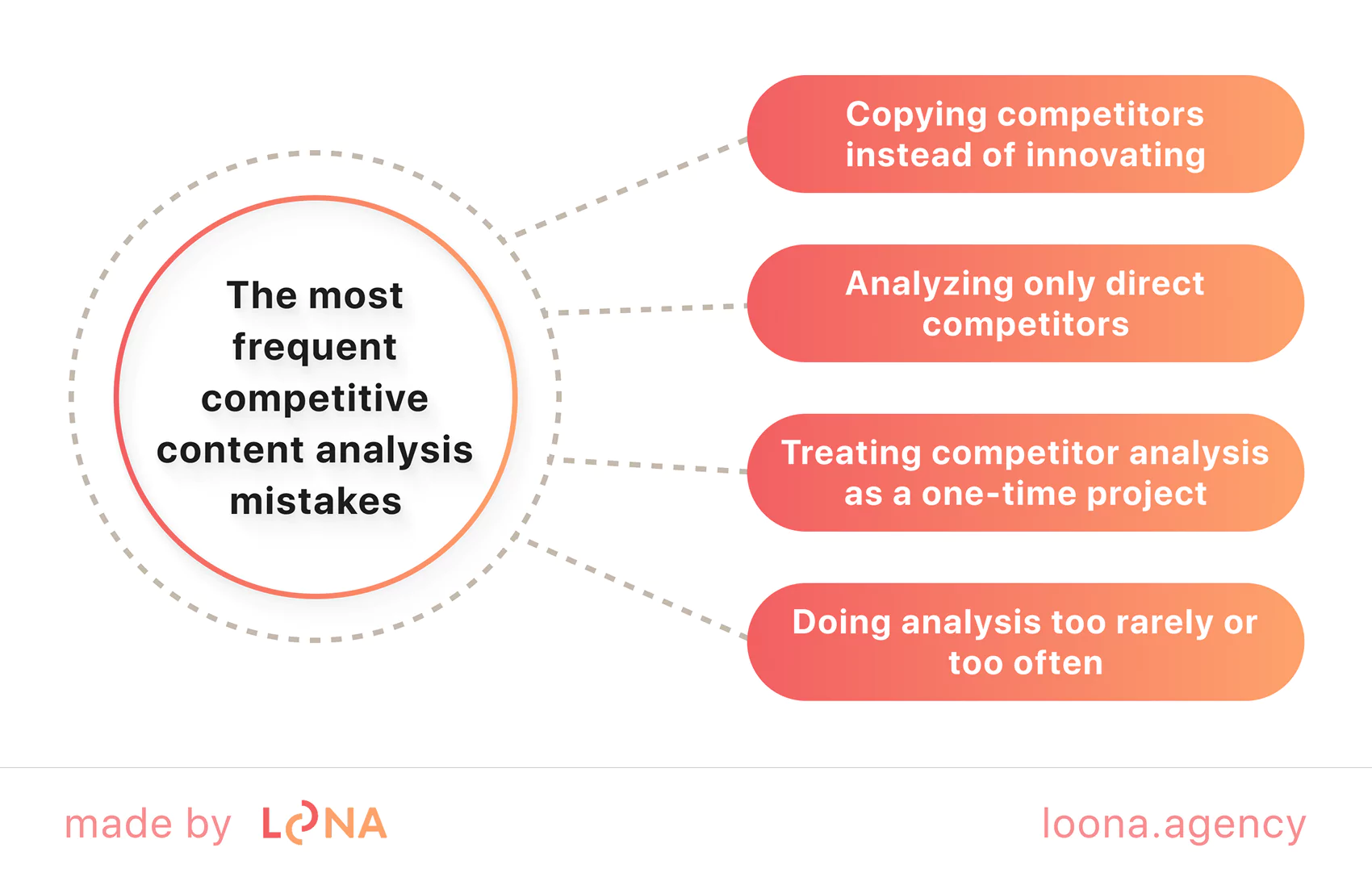
1. Copying competitors instead of innovating
Many businesses fall into the trap of thinking competitor analysis means duplicating what others are doing. They copy keywords, blog structures, even visuals, hoping similar tactics will bring similar results. In reality, this approach only makes your content blend into the crowd instead of differentiating.
The purpose of competitor analysis is to identify gaps and opportunities your rivals missed. By innovating on what competitors do, creating deeper content, better UX, or unique angles, you position your brand as a leader rather than a follower.
2. Analyzing only direct competitors
Another common mistake is narrowing your analysis to companies selling the exact same product or service. While they matter, content competitors often dominate the search results your audience sees. Ignoring them creates blind spots in your strategy.
Map both direct and indirect competitors to understand everyone fighting for the same attention. The wider view often uncovers unexpected rivals and new opportunities for content angles or distribution channels.
3. Treating competitor analysis as a one‑time project
Some businesses perform competitor analysis during a site launch or campaign planning. But algorithms, user behavior, and competitors themselves change constantly. Outdated insights lead to strategies that no longer match current realities.
Regular reviews ensure you spot shifts in rankings, messaging, and content types early. Loona Agency recommends quarterly deep dives combined with ongoing monitoring to maintain a proactive marketing approach.
4. Doing analysis too rarely or too often
In how to see competitors marketing strategy, frequency is just as important as methodology. Analyzing competitors once a year leaves you blind to new threats or opportunities, while doing it weekly can waste resources and cause strategy paralysis.
A balanced cadence works best: quarterly reviews for major insights, with lighter ongoing checks to track sudden changes. Loona Agency’s clients benefit from automated monitoring tools combined with expert reviews, ensuring they act on meaningful trends.
The Loona Agency ’s revealing case studies: Plum, Avva, Intobi
At Loona Agency, we’ve helped diverse businesses across industries uncover what their competitors are doing, find gaps, and translate those findings into measurable results. Below are three examples: Plum ProExteriors, Avva Experience, and Intobi. They highlight how competitor content marketing analysis directly shaped their success.
Plum ProExteriors
An exterior remodeling company in Massachusetts struggled to compete with local firms dominating search results. Despite high-quality services, their website and local SEO visibility made it hard for potential customers to find them. Loona began by mapping every competitor in the area, identifying keyword coverage, backlink strategies, and gaps in service positioning.
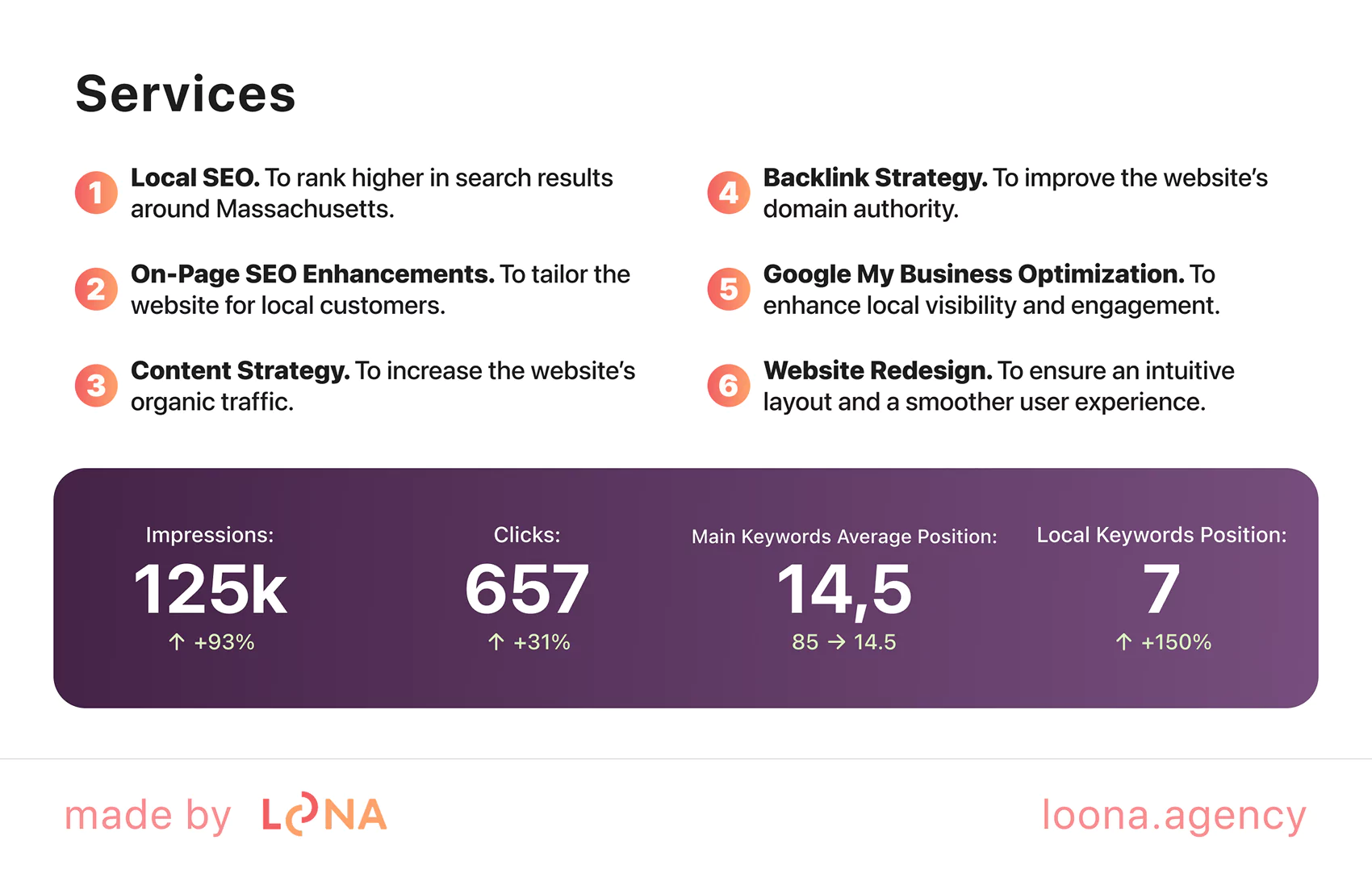
This deep competitor analysis revealed opportunities to outpace rivals by targeting hyper-local keywords, improving mobile usability, and crafting content around specific homeowner pain points. After implementing these insights, from a full site redesign to optimized local SEO, Plum saw a 900% traffic increase and doubled their domain authority, quickly climbing to top positions in local search.
Avva Experience
This provider of virtual corporate team-building events, faced fierce competition from entertainment and HR-focused platforms in both the US and UK. Their rankings were stagnant due to weak backlinks, thin content, and inconsistent keyword targeting. Loona’s first move was a comprehensive competitor audit, mapping how rival platforms attracted traffic and converted leads.
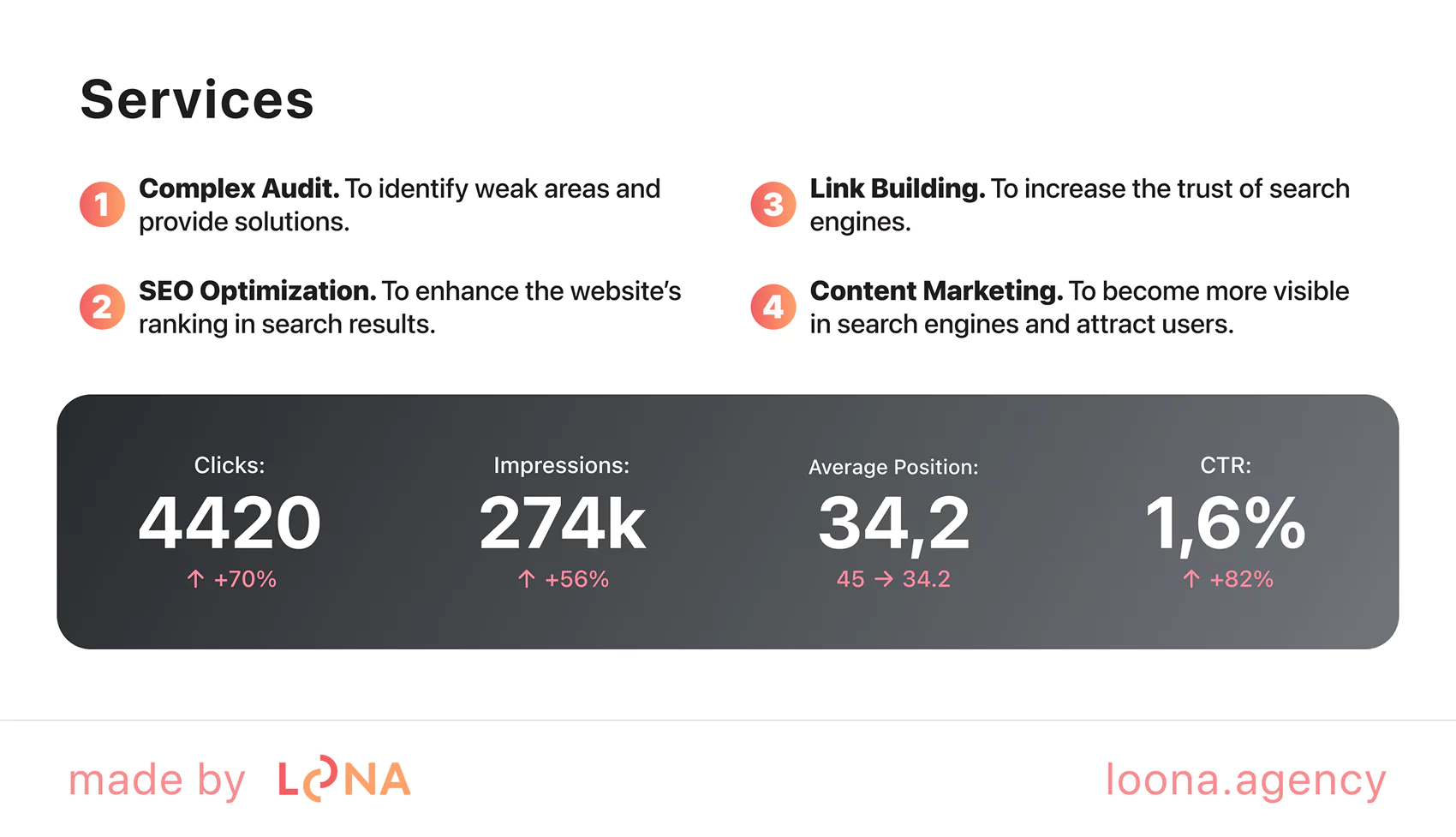
We discovered gaps in topic depth, missed high-value keywords, and untapped engagement opportunities. By addressing these areas with improved content marketing and a robust link-building plan, Avva’s organic traffic grew by 950% in months. The brand now outperforms competitors in several core topics and dominates niche searches relevant to their events.
Intobi
A Texas-based software development company, offered top-tier services but struggled against competitors with stronger digital presences. Their outdated site and low authority caused them to lose leads to firms with more polished strategies. Loona Agency conducted competitive benchmarking, comparing site performance, UX, keyword targeting, and backlink strength against top industry players.
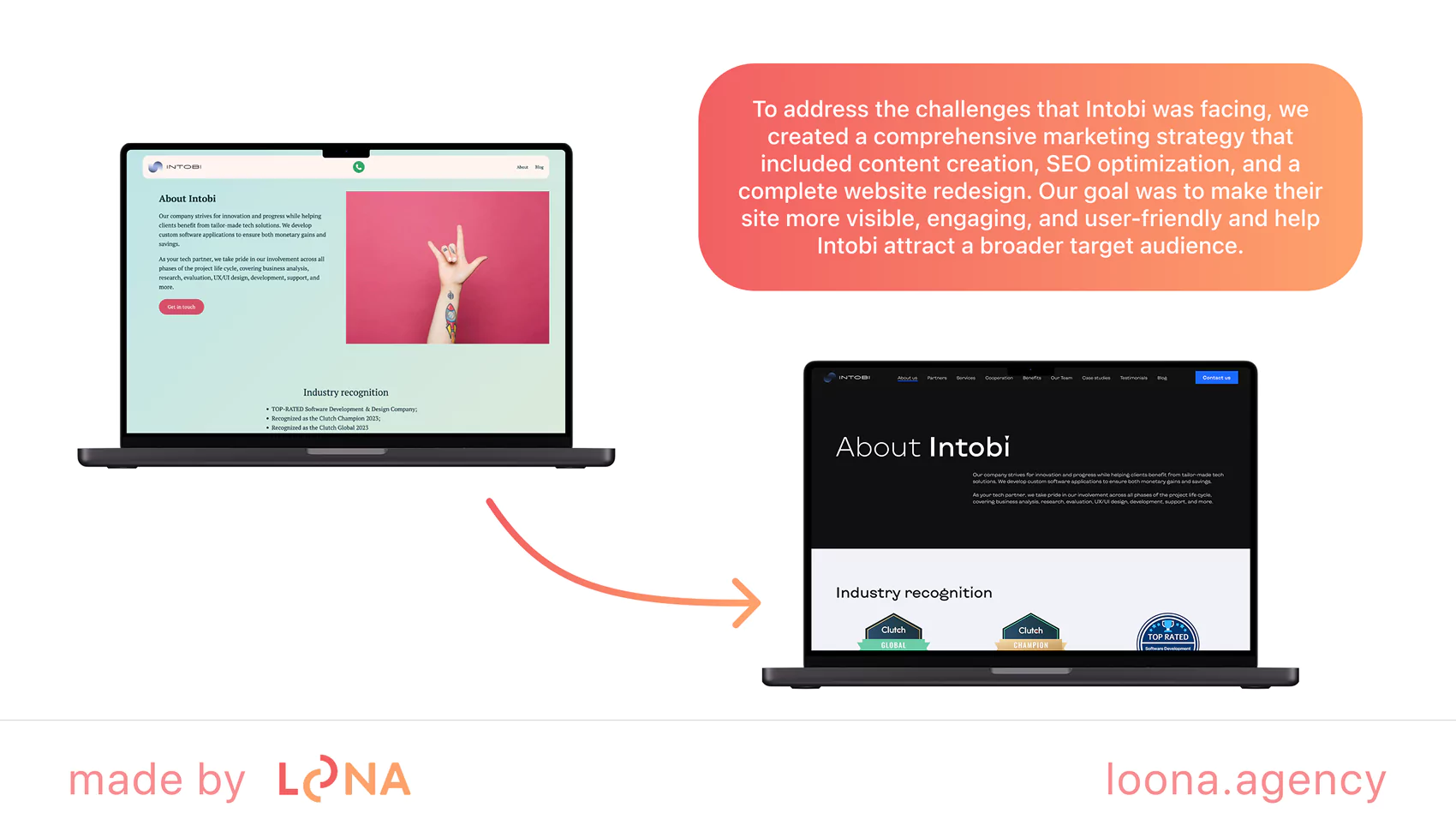
Findings guided a complete website redesign, SEO overhaul, and content repositioning tailored to outperform key rivals. As a result, Intobi achieved a 348% traffic increase and boosted their domain rating by 15 points, while capturing top rankings for critical brand keywords. Their new digital presence now rivals, and often surpasses, established industry leaders.
Final thoughts: Make competitor analysis part of your workflow
Following the steps we’ve outlined in this article, you won’t just know what your competitors are doing but how to use those insights to gain an edge. These strategies will help turn competitor content marketing analysis into one of the most powerful levers in your content marketing workflow.
In general, knowing who you’re up against is the first move toward building content that outperforms them. If you don’t feel confident in how to do content marketing competitor analysis so that you don’t waste your budget, we can make the most out of it. Loona Agency is your competitive advantage and catalyst for building content strategies that lead the market.
Contact us today and discover the opportunities your competitors are missing!
Sincerely, your Loona Agency.







